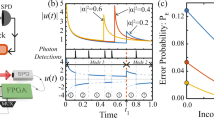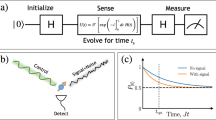Abstract
Quantum mechanics hinders our ability to determine the state of a physical system in two ways: individual measurements provide only partial information about the observed system (because of Heisenberg uncertainty), and measurements are themselves invasive—meaning that little or no refinement is achieved by further observation of an already measured system1. Theoretical methods have been developed to maximize the information gained from a quantum measurement while also minimizing disturbance2,3,4, but laboratory implementation of optimal measurement procedures is often difficult. The standard class of operations considered in quantum information theory5 tends to rely on superposition-basis and entangled measurements6, which require high-fidelity implementation to be effective in the laboratory7. Here we demonstrate that real-time quantum feedback8,9,10 can be used in place of a delicate quantum superposition, often called a ‘Schrödinger cat state’, to implement an optimal quantum measurement for discriminating between optical coherent states11,12. Our procedure actively manipulates the target system during the measurement process, and uses quantum feedback to modify the statistics of an otherwise sub-optimal operator to emulate the optimal cat-state measurement. We verify a long-standing theoretical prediction13 and demonstrate feedback-mediated quantum measurement10,14 at its fundamental quantum limit over a non-trivial region of parameter space.
This is a preview of subscription content, access via your institution
Access options
Subscribe to this journal
Receive 51 print issues and online access
$199.00 per year
only $3.90 per issue
Buy this article
- Purchase on Springer Link
- Instant access to full article PDF
Prices may be subject to local taxes which are calculated during checkout



Similar content being viewed by others
References
von Neumann, J. Mathematical Foundations of Quantum Mechanics (Princeton Univ. Press, Princeton, 1955)
Kraus, K. Lecture Notes in Physics Vol. 190, States, Effects, and Operations: Fundamental Notions of Quantum Theory (Springer, Berlin, 1983)
Peres, A. & Wooters, W. K. Optimal detection of quantum information. Phys. Rev. Lett. 66, 1119–1122 (1991)
Fuchs, C. A. & Peres, A. Quantum-state disturbance versus information gain: Uncertainty relations for quantum information. Phys. Rev. A 53, 2038–2045 (1996)
Nielsen, M. & Chuang, I. Quantum Computation and Quantum Information Science (Cambridge Univ. Press, Cambridge, UK, 2000)
Peres, A. Neumark’s theorem and quantum inseparability. Found. Phys. 20, 1441–1453 (1990)
Leibfried, D. et al. Toward Heisenberg-limited spectroscopy with multiparticle entangled states. Science 304, 1476–1478 (2004)
Wiseman, H. M. & Milburn, G. J. All-optical versus electro-optical quantum-limited feedback. Phys. Rev. A 49, 4110–4125 (1994)
Doherty, A. C., Habib, S., Jacobs, K., Mabuchi, H. & Tan, S. M. Quantum feedback control and classical control theory. Phys. Rev. A 62, 012105–012117 (2000)
Geremia, J., Stockton, J. K. & Mabuchi, H. Real-time quantum feedback control of atomic spin-squeezing. Science 304, 270–273 (2004)
Helstrom, C. W. Detection theory and quantum mechanics. Inform. Control 10, 254–291 (1967)
Sasaki-Usuda, T. & Hirota, O. in Quantum Communication and Measurement (eds Belavkin, V. P., Hirota, O. & Hudson, L.) 419–428 (Plenum, New York, 1995)
Dolinar, S. Quarterly Progress Report (Tech. Rep. 111, Research Laboratory of Electronics, MIT, 1973)
Armen, M. A., Au, J. K., Stockton, J. K., Doherty, A. C. & Mabuchi, H. Adaptive homodyne measurement of optical phase. Phys. Rev. Lett. 89, 133602–133605 (2002)
Helstrom, C. W. Mathematics in Science and Engineering Vol. 123, Quantum Detection and Estimation Theory (Academic, New York, 1976)
Fuchs, C. A. Distinguishability and Accessible Information in Quantum Theory. Ph.D. thesis, Univ. New Mexico (1996); 〈http://arxiv.org/quant-ph/9601020〉 (1996)
Geremia, J. Distinguishing between optical coherent states with imperfect detection. Phys. Rev. A 70, 062303–062311 (2004)
Sasaki, M. & Hirota, O. Quantum decision scheme with a unitary control process for binary quantum-state signals. Phys. Rev. A 54, 2728–2736 (1996)
Wiseman, H. M. Adaptive phase measurements of optical modes: Going beyond the marginal Q distribution. Phys. Rev. Lett. 75, 4587–4590 (1995)
Acknowledgements
We thank H. M. Wiseman, H. Mabuchi, S. Dolinar, K. Jacobs, A. Landahl, C. Caves, I. Deutsch and P. Jessen for discussions. This work was supported by the AFOSR and the New Mexico NSF EPSCoR programme in nanotechnology.
Author Contributions All authors contributed equally to this work.
Author information
Authors and Affiliations
Corresponding author
Ethics declarations
Competing interests
Reprints and permissions information is available at www.nature.com/reprints. The authors declare no competing financial interests.
Rights and permissions
About this article
Cite this article
Cook, R., Martin, P. & Geremia, J. Optical coherent state discrimination using a closed-loop quantum measurement. Nature 446, 774–777 (2007). https://doi.org/10.1038/nature05655
Received:
Accepted:
Issue Date:
DOI: https://doi.org/10.1038/nature05655
This article is cited by
-
Demonstration of \(\mathcal{P}\mathcal{T}\)-symmetric quantum state discrimination
Quantum Information Processing (2024)
-
Discriminating mixed qubit states with collective measurements
Communications Physics (2023)
-
Training a quantum measurement device to discriminate unknown non-orthogonal quantum states
Scientific Reports (2023)
-
Quantum receiver enhanced by adaptive learning
Light: Science & Applications (2022)
-
Demonstration of optimal non-projective measurement of binary coherent states with photon counting
npj Quantum Information (2022)
Comments
By submitting a comment you agree to abide by our Terms and Community Guidelines. If you find something abusive or that does not comply with our terms or guidelines please flag it as inappropriate.



